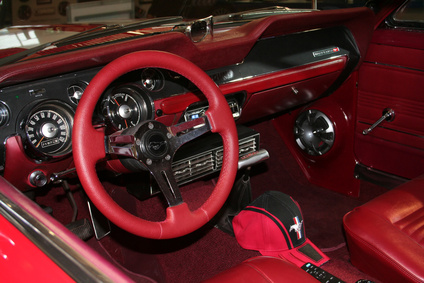
The 1969 Mustang is a classic automobile that helped increase Ford's popularity. Being part of the first generation of the Mustang model, the 1969 had unique styling, especially on the front end with a wider grille and four headlights. For the front end, the 1969 model had significant performance specifications that relied on the powerful engine under its hood.
The 1969 Mustang is 187.4 inches long, 71.8 inches wide and 50.3 inches high with a curb weight of 3,571 pounds. The F70x14 tires complement the 108-inch wheelbase and 58.5-inch track on both the front and the rear. This Mustang has a 20-gallon fuel tank capacity and boasts 290 horsepower at 4,800 RPM and 385 ft.-lbs. of torque at 3,200 RPM. In addition, this vehicle goes from 0 to 60 miles in 7.5 seconds, with a top gear ratio of 1.00, a final drive ratio of 3.25 and an official top speed of 119 MPH. Furthermore, for a vehicle with a 179.01 BHP (ton power-to-weight ratio) and a three-speed transmission, the 1969 Mustang takes the 1/4-mile from a standing start in 15.6 seconds at 88 MPH. For the design, the biggest change to the front end was a front grille opening, displaying the four headlights used only on this model. The interior has a racer theme.
There were seven different engines available for the 1969 Mustang. The first was a 200-cubic inch, I-6 one valve carburetor with a compression ratio of 8.8:1, a horsepower of 115 at 2,800 RPM and a torque of 190 at 2,400 RPM. The second was a larger engine at 250 cubic inches that had an I-6 carburetor with one valve. This resulted in a higher compression ratio of 9:1, a horsepower of 155 at 4,000 RPM and a torque of 240 ft.-lbs. at 2,400 RPM. The third option was a 302-cubic inch engine but was a V8, with a two-valve carburetor. The compression ratio was 9:5, producing 220 horsepower at 4,600 RPM. The torque was 300 ft.-lbs. at 2,600 RPM. The fourth engine was even more powerful, at 351 cubic inches. The V8, two-valve carburetor produced 250 horsepower at 4,600 RPM, a torque of 355 ft.-lbs. at 2,600 RPM and a compression ratio of 10:1. The fifth option offered 351 cubic inches but was a V8 with a four-valve carburetor producing 290 horsepower at 4,800 RPM and a torque of 385 ft.-lbs. at 3,200 RPM. The compression ratio was 10.7:1. The sixth option was a 390-cubic inch V8 with a four-valve carburetor, boasting a compression ratio of 10.6:1. The horsepower was 335 at 5,200 RPM with a powerful torque of 427 ft.-lbs. at 3,200 RPM. Finally, the seventh option was the most powerful of all: A 428-cubic inch Cobra Jet engine with a four-valve carburetor. The compression ratio of this powerplant was 10.6:1, and it had a horsepower rating of 335 at 5,200 RPM. The torque was 440 ft.-lbs. at 3,400 RPM.
The 1969 Mustang was a member of the first generation, so it has a short-long arm, or SLA, front suspension. This suspension is designed for fully adjustable camber, caster and toe--all of which are essential for proper alignment. The camber and caster are adjustable at the upper control arm with original equipment shims, whereas the rear is not adjustable. Wheel alignment for this vehicle should be done along the thrust line. For the 1969 model, the caster should be adjusted through the strut-rod adjustment nuts that control the strut rod, lower control arm and spindle. The camber on a 1969 Mustang must be adjusted by an eccentric on the lower control arm, but the upper control arms are not adjustable as they are in a fixed position. For the toe, a classic Mustang from 1969 requires more of a toe-out position that will keep the vehicle straight. You want a caster between a positive 1.5 degrees and a positive 2.5 degrees, with a camber ranging from 0 to a negative .5 degrees. The toe should be around 1/8 of an inch.